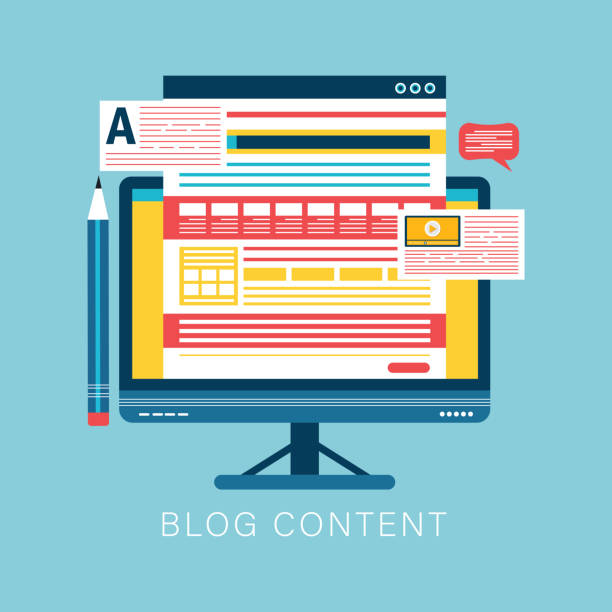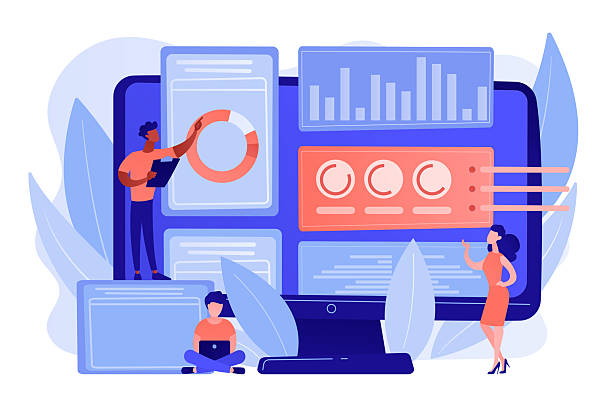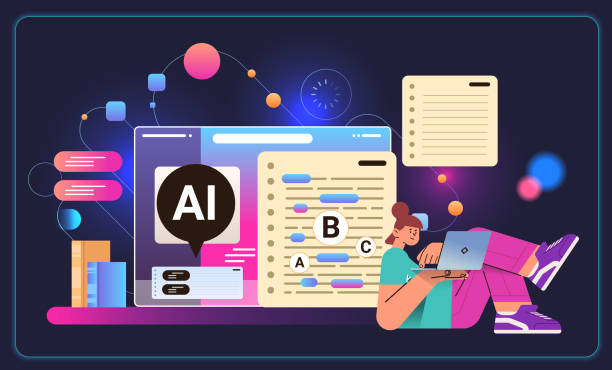Why is Fast Website Design Important?

In today’s digital world, speed is paramount.
#FastWebsiteDesign is not just an advantage, but an absolute necessity for any online business.
Internet users today expect websites to load quickly and without delay; otherwise, they easily leave the page and move on to the next competitor.
This phenomenon, known as a high Bounce Rate, directly leads to decreased sales and lost business opportunities.
Beyond user experience, site speed is a key factor in #SEO (Search Engine Optimization).
Search engines like Google rank faster websites higher in their search results because they provide a better user experience.
This is a positive cycle: #FastWebsiteDesign leads to better rankings, attracting more traffic, and ultimately increasing conversion rates.
Understanding the fundamental importance of speed for every type of website, from online stores to personal blogs and news portals, is crucial.
The importance of fast web page loading cannot be underestimated.
Realizing how a speed-optimized website can have major impacts on online success is the first step towards building a powerful digital presence.
This involves a comprehensive approach to optimizing all site elements.
Loading speed is not only important for the end-user but also vital for search engine crawling capabilities and page indexing.
The faster your site, the more pages Google crawlers can examine in less time, which helps improve your site’s indexing and visibility.
This is why every modern digital marketing strategy must prioritize speed optimization.
This is an #explanatory and #analytical aspect of web architecture that directly impacts revenue and brand credibility.
Is your current e-commerce website design causing you to lose customers and sales?
Rasaweb is your solution with modern and user-friendly e-commerce website designs!
✅ Significant increase in conversion rates and sales
✅ Creation of strong branding and building customer trust
⚡ Get a free e-commerce website design consultation from Rasaweb!
Key Factors Affecting Website Speed

Website speed is influenced by numerous factors, and identifying and optimizing them is essential for achieving the best performance.
One of the most important factors is Server Response Time.
A slow server or poor hosting can render even the most optimized code ineffective.
Choosing a reliable and powerful web hosting provider with optimized servers close to the target audience is the first step in increasing page loading speed.
The next critical factor is efficient and optimized coding.
Poorly written HTML, CSS, and JavaScript codes, full of unnecessary or render-blocking code, can severely reduce site speed.
Removing unnecessary code, Minification, combining CSS and JS files, and using Asynchronous Loading for scripts are key methods to improve this aspect.
Images and multimedia files also play a significant role in determining site speed.
High-volume and unoptimized images can drastically increase page load time.
Using appropriate image formats like WebP, compressing images without significant quality loss, and implementing Lazy Loading for images outside the user’s viewport are fundamental techniques in this area.
Heavy databases and inefficient queries can also affect website speed.
Optimizing database structure and queries for faster information access is another #specialized aspect for improving overall site performance.
Using Content Management Systems (CMS) like WordPress, Joomla, or Drupal, if not properly optimized, can lead to slowness.
Installing too many heavy plugins or unsuitable themes also exacerbates this problem.
Careful plugin management and selecting speed-optimized themes are important #educational tips in this regard.
By optimizing these factors, a “fast website design” can be achieved, offering a better user experience.
Practical Tools and Techniques for Increasing Site Speed

To achieve “fast website design,” knowing and utilizing effective tools and techniques is essential.
Website speed analysis tools like Google PageSpeed Insights, GTmetrix, and Pingdom Tools provide precise information about your website’s performance and identify weaknesses.
These tools not only show a speed score but also offer practical recommendations for improvement, which is valuable #guidance for any web developer.
One of the main techniques for increasing speed is Minification of CSS, JavaScript, and HTML files.
This process involves removing whitespace, comments, and unnecessary code from files, which helps reduce their size and consequently speeds up loading.
Lazy Loading for images and videos means that multimedia content is only loaded when the user scrolls to the relevant section and that content enters the viewport.
This prevents unnecessary resource loading at the initial entry of the user.
Using Content Delivery Networks (CDNs) to distribute static site files from servers closer to geographical users significantly reduces response time.
This is a #specialized step towards global optimization.
Caching also plays a very important role.
By enabling browser caching, static files like images, CSS, and JS are stored in the user’s browser on the first visit.
On subsequent visits, these files are loaded from the cache, eliminating the need to re-download from the server, which significantly helps “increase loading speed.”
Choosing light and optimized themes and plugins in Content Management Systems like WordPress is also of high importance.
Sometimes, too many or heavy plugins can drastically reduce site speed, so smart selection and optimal management are necessary.
These #educational techniques are an essential part of any strategy for “fast website design.”
The table below shows some important tools for checking and optimizing website speed:
| Tool Name | Primary Use | Key Features |
|---|---|---|
| Google PageSpeed Insights | Mobile and Desktop Speed Analysis | Scoring based on Core Web Vitals, specific optimization suggestions |
| GTmetrix | Comprehensive Site Performance Report | Waterfall chart of loaded resources, detailed suggestions |
| Pingdom Tools | Speed Test from Various Geographical Locations | Displays full load time, page size, number of requests |
| WebPageTest | Advanced Web Performance Testing | Ability to test from various browsers and locations, video recording of loading |
The Role of CDN and Caching in Enhancing Web Performance

Content Delivery Networks (CDN) and Caching mechanisms are two main pillars in a “fast website design” strategy that play a vital role in optimizing web performance.
A CDN is a network of distributed servers in different geographical locations that stores your website’s static content (such as images, CSS, and JavaScript files) and delivers it from the closest server to the end-user.
This significantly reduces latency and improves loading time, especially for users who are geographically distant from the site’s main server.
For example, if your main server is in Europe and a user in Asia accesses your site, the CDN delivers content from a server in Asia or the closest possible point to them, minimizing the distance and data transfer time.
This is an #analytical approach to globally improving content accessibility.
Caching also refers to the temporary storage of data for faster access in the future.
There are different types of caching, each effective in “increasing loading speed.”
Browser Caching allows the user’s browser to store static site files in its memory after the first visit.
This means that on subsequent visits or when navigating between site pages, there is no need to re-download these files from the server, and pages load quickly.
Server-Side Caching involves storing processed outputs on the server side so that requests do not need to be re-processed every time.
This can include database caching, Object Caching for storing query results, and Page Caching for storing entire HTML pages.
Page caching helps web pages be delivered statically and readily instead of being regenerated from scratch for each request.
The intelligent combination of CDN and caching strategies dramatically reduces the load on the main server and optimizes page loading time, both of which are crucial for “web performance optimization” and providing a seamless user experience.
These #specialized techniques are the foundation for creating high-speed websites at scale.
Are you disappointed with your online store’s low conversion rate?
Rasaweb is your definitive solution with professional e-commerce website design!
✅ Increase your sales and revenue
✅ Provide an unparalleled user experience for your customers
⚡ Get a free consultation now!
The Impact of Site Speed on SEO and Search Engine Rankings

In the complex ecosystem of search engines, website speed is not only a convenience factor for users but also a critical ranking factor for SEO.
Google and other search engines are increasingly emphasizing page load speed as a metric for evaluating the quality of user experience.
This means that a “fast website design” can directly influence your position in search results.
Google’s introduction of Core Web Vitals has further highlighted this importance.
Core Web Vitals are a set of metrics related to a site’s speed, interactivity, and visual stability, including Largest Contentful Paint (LCP), First Input Delay (FID), and Cumulative Layout Shift (CLS).
LCP measures the time it takes for the largest content element on the page to load, indicating the main loading speed.
FID evaluates the site’s responsiveness to user input.
CLS measures the visual stability of the page and prevents unwanted element shifts.
Poor performance in any of these metrics can lead to a drop in SEO ranking, even if your content is of very high quality.
Furthermore, site speed also affects the search engine’s Crawl Rate.
If your website is slow, search engine crawlers cannot adequately examine your pages within a specified time.
This may lead to new content not being fully or timely indexed, which is a serious problem for #news websites or those with dynamic content.
From a user’s perspective, a slow site means a higher bounce rate; users who don’t wait and leave the site.
This user behavior sends negative signals to search engines and can be perceived as an indication of a poor user experience.
Therefore, investing in “web performance optimization” for SEO and achieving top rankings is a #specialized and strategic decision that cannot be overlooked.
Ultimately, site speed not only keeps visitors satisfied but also helps search engines recognize the true value of your website and introduce it to a wider audience.
The Importance of Site Speed in User Experience and Conversion Rate

Beyond technical metrics and SEO rankings, site speed is inextricably linked to user experience (UX) and, ultimately, to the conversion rate.
A “fast website design” directly impacts user satisfaction.
In the age of high-speed internet, users expect websites to load instantly.
Numerous studies have shown that even a few seconds’ delay in page loading can lead to a sharp increase in bounce rate.
This means losing potential visitors who leave the site even before seeing your content.
This is an important #analytical point that businesses must consider.
Imagine a user searching to buy a specific product.
If your website is slow to load product information, add to cart, or complete the payment process, there’s a very high probability that the user will lose patience and go to a competitor’s site.
This directly leads to a decrease in the Conversion Rate, whether the conversion means sales, registrations, file downloads, or filling out a contact form.
A high-speed website conveys a sense of efficiency and credibility to the user and builds their trust.
Users feel they are dealing with a professional and reliable platform that respects their time.
This positive feeling can help increase engagement, time spent on the site, and the likelihood of a visitor becoming a loyal customer.
In contrast, a slow site can cause frustration, disappointment, and ultimately a negative user experience, even if your content or products are excellent.
The psychological effects of speed on users are sometimes underestimated.
A smooth and uninterrupted user experience can create an #engaging and satisfying feeling that makes users return more often and interact with your site.
In summary, site speed is the backbone of an excellent user experience and ultimately a decisive factor in the success or failure of your online business and “user experience optimization.”
This is practical #guidance for anyone looking to improve their website’s performance.
Common Challenges in Fast Website Design and Their Solutions

Despite significant advancements in web technology, achieving “fast website design” still comes with challenges.
Understanding these challenges and implementing effective solutions to overcome them is key to success.
One of the most common challenges is the high volume of multimedia files, especially images and videos.
These files can quickly increase the overall page size and drastically raise loading times.
The solution to this problem is meticulous optimization of these files through high-quality compression, using modern formats like WebP, and implementing Lazy Loading.
Excessive use of Third-Party Scripts such as analytical tools, advertisements, or social media plugins can also slow down site speed.
These scripts often rely on external resources, and their loading can be time-consuming.
The solution is to use only essential scripts and load them asynchronously or with defer.
Inefficient coding or Render-Blocking CSS and JavaScript codes are also major challenges.
These codes prevent the page from rendering until they are fully loaded and executed.
Minification, combining files, and moving JavaScript scripts to the bottom of the page (before the closing </body> tag) can solve this problem.
Hosting Limitations are another obstacle to “increasing loading speed.”
Inexpensive shared hosting may not have sufficient resources to handle high traffic or complex request processing.
Migrating to Virtual Private Servers (VPS), dedicated servers, or cloud solutions can significantly improve performance.
This is a #common_question that site owners often face.
Improper use of caching or CDN can also affect speed.
A thorough understanding of caching types and implementing an appropriate CDN for your website are vital steps in overcoming these challenges.
The complexity of Content Management Systems (CMS) and a large number of plugins can also lead to slowness.
Choosing a lightweight and optimized CMS, careful plugin management, and removing unnecessary items are effective solutions.
These challenges indicate that “fast website design” is a continuous and multifaceted process that requires constant review and optimization.
The table below shows some common challenges and their typical solutions:
| Common Challenge | Suggested Solution | Additional Details |
|---|---|---|
| High-volume images | Compression, Lazy Loading, WebP format | Utilize image optimization tools and responsive image delivery services |
| Render-blocking codes (CSS/JS) | Minification, concatenation, Asynchronous/Defer loading | Check PageSpeed Insights reports to identify problematic codes |
| Poor web hosting | Upgrade to VPS, dedicated server, or cloud hosting | Choose a reputable provider with optimized servers and strong support |
| Lack of caching or CDN | Implement browser, server caching, and CDN | Use caching plugins (in CMS) and popular CDN services |
The Future of Fast Website Design and Emerging Technologies

The web world is constantly evolving, and with it, the techniques and technologies used for “fast website design” are also advancing.
The future of the web is moving towards greater speed, better responsiveness, and a richer user experience.
One of the most important emerging trends is Progressive Web Apps (PWAs).
PWAs are websites that offer mobile application capabilities (such as offline functionality, push notifications, and device hardware access) while retaining their website nature.
This technology allows websites to load much faster and provide a seamless user experience that is almost comparable to native applications.
AMP (Accelerated Mobile Pages) is another Google initiative specifically designed to deliver very fast web pages on mobile devices.
By restricting certain HTML and JavaScript elements and using advanced caching, AMP loads pages at incredible speeds, ideal for #news content and blogs.
Network technologies are also advancing.
The transition from HTTP/2 to HTTP/3, built on the QUIC protocol, promises reduced latency and improved performance on unstable networks.
HTTP/3, by addressing some limitations of HTTP/2, will contribute to “fast website design” on a global scale.
Serverless Functions and Edge Computing technologies are also moving towards processing data at the closest point to the user.
This helps reduce latency in processing requests and delivering content, providing another layer of speed optimization.
The use of Artificial Intelligence (AI) and Machine Learning (ML) in web performance optimization is also increasing.
These technologies can analyze traffic patterns, predict, and dynamically allocate resources to achieve “web performance optimization” automatically and intelligently.
These trends indicate that “fast website design” will remain a focus for developers and search engines, and with the emergence of each new technology, standards will continue to rise.
This is an #analytical and growing field that brings exciting innovations.
Are you tired of your e-commerce site having visitors but no sales? Rasaweb solves your main problem with professional e-commerce website designs!
✅ Significant sales increase with targeted design
✅ Flawless user experience for your customers
⚡ Get a free consultation!
Common Mistakes in Website Speed Optimization and How to Prevent Them

Despite the importance of “fast website design,” many developers and website owners make mistakes that negate their speed optimization efforts.
Understanding these mistakes and ways to prevent them is essential for achieving optimal performance.
One common mistake is neglecting mobile speed.
Given the increasing mobile traffic, optimizing only for desktop is insufficient.
It must be ensured that the website loads quickly on both mobile and desktop and provides a seamless user experience.
Solely focusing on scoring tools (like PageSpeed Insights) and ignoring the actual user experience, is another mistake.
Sometimes, to achieve a high score, sacrifices are made regarding usability or content, which ultimately harms the user.
The primary goal should always be user experience, not just a score.
Overuse of plugins or extensions in Content Management Systems (CMS) like WordPress is also a common pitfall.
Each plugin adds its own CSS, JavaScript codes, and database queries, which can lead to slowness.
Use only essential and lightweight plugins and remove inactive ones.
Ignoring server-side issues, including poor hosting or incorrect server configuration, is another mistake.
Even the best front-end optimizations cannot save a slow server.
Investing in quality hosting and proper server configuration is crucial for “increasing loading speed.”
Failure to compress and optimize images and multimedia files is also a frequent mistake.
Many websites load a large amount of unoptimized visual data, which significantly increases load time.
Always compress images before uploading and use Lazy Loading.
Neglecting regular maintenance and performance monitoring can also lead to a gradual decline in speed.
Websites are living entities that require continuous updates, database optimization, and performance checks.
This is an important #educational and #guidance point that should not be forgotten.
These mistakes show that “fast website design” requires a comprehensive and continuous approach to prevent performance degradation.
Conclusion and Final Tips for Designing a High-Speed Website

In conclusion of this comprehensive review, it is clear that “fast website design” is not just an option, but a vital requirement for success in today’s online space.
Website speed directly affects user experience, search engine rankings, and ultimately your business’s conversion rates and profitability.
Key points to always keep in mind include careful optimization of all website elements, from images and code to server and network infrastructure.
Using analytical tools to identify speed bottlenecks and implementing advanced techniques such as caching and CDN are fundamental principles for “increasing loading speed.”
Furthermore, it is very important to understand that speed optimization is not a one-time process, but rather requires continuous monitoring and regular updates.
Given the rapid evolution of web technologies, keeping pace with the latest innovations and best practices is crucial for maintaining your website’s competitiveness.
The importance of fast web page loading cannot be overemphasized, as every user expects a smooth and delay-free experience.
Investing in a “fast website design” will yield significant long-term results, including increased customer satisfaction, improved search rankings, and business growth.
The final recommendation is to always look at your website from the user’s perspective.
Does it provide the experience, speed, and convenience you expect from a website?
If the answer is no, then it’s time to take the necessary steps for optimization.
This is comprehensive #guidance for anyone who wants to shine in the competitive world of the web.
By adhering to these principles and paying attention to details, you can build a website that is not only beautiful and functional but also attracts and retains users with its exceptional speed.
Frequently Asked Questions
| No. | Question | Answer |
|---|---|---|
| 1 | What does fast website design mean? | Optimizing a website for quick page loading, improved user experience, and SEO ranking. |
| 2 | Why is website loading speed important? | Increases user satisfaction, reduces bounce rate, improves SEO, and boosts conversion rates (sales/actions). |
| 3 | What tools are available for testing website speed? | Google PageSpeed Insights, GTmetrix, and Pingdom Tools are common tools. |
| 4 | What are the main factors causing a slow website? | Unoptimized images, heavy JavaScript and CSS codes, poor hosting, and lack of caching. |
| 5 | What is Caching and how does it help website speed? | Temporary storage of website data in the user’s browser or on the server for faster loading on subsequent visits. |
| 6 | How can we optimize images to increase website speed? | Reducing image size (compression) without significant quality loss, using modern formats (WebP), and setting appropriate dimensions. |
| 7 | What role does CDN (Content Delivery Network) play in fast website design? | Distributes website content across various servers worldwide to deliver content from the closest server to the user. |
| 8 | Does choosing suitable hosting (web hosting) affect website speed? | Yes, quality hosting with powerful servers is essential for fast website loading. |
| 9 | What is the Minification technique and why is it used? | Removing extra characters (whitespace, comments) from HTML, CSS, JavaScript codes to reduce file size. |
| 10 | What is the relationship between responsive design and website speed? | Responsive design means correct display on different devices; if not implemented correctly, it can create extra load and reduce speed. Responsive optimization is important for speed. |
And other services of Rasaweb Advertising Agency in the field of advertising
Smart Custom Software: A blend of creativity and technology to analyze customer behavior using real data.
Smart Marketplace: A professional solution to increase website traffic with a focus on attractive UI design.
Smart Brand Identity: An innovative service to increase click-through rates through precise audience targeting.
Smart Link Building: A combination of creativity and technology to boost click-through rates through exclusive programming.
Smart Advertorial: A professional solution to attract customers with a focus on precise audience targeting.
And over a hundred other services in the field of internet advertising, advertising consultation, and organizational solutions
Internet Advertising | Advertising Strategy | Advertorial
Sources
Importance of Website Speed Optimization
Website Design Challenges and Solutions
Impact of Site Speed on SEO
Principles of Professional Website Design
? Are you ready to transform your business in the digital world? At Rasaweb Afarin Digital Marketing Agency, with our expertise in user-friendly website design and implementing comprehensive digital strategies, we help you establish a powerful and effective online presence. From SEO and online advertising to social media management, we are your digital partner in achieving your goals.
📍 Tehran, Mirdamad Street, next to Bank Markazi, Southern Kazeroun Alley, Ramin Alley, No. 6

